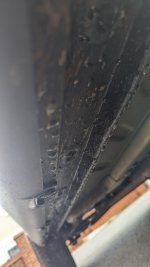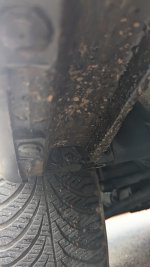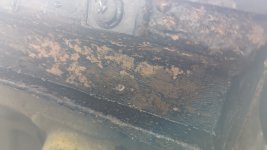Last pads I bought came with new springs, in fact I can’t remember a time wehn they haven’t…and I’ve been buying Fiat parts from GGB since the 80’s…I know some of the cheap spurious ones don’t alwaysThe guides on the 500 were dry, and then rusty that jammed the pad on ours.
The pads should sit neat, not loose. Neat but no force required. On non-fiat, the metal spring shims hold them quite firm, even still I put a smear of copper grease on the stainless shims since they also seems to corrode with time.
You are using an out of date browser. It may not display this or other websites correctly.
You should upgrade or use an alternative browser.
You should upgrade or use an alternative browser.
General Rusty brakes again.
- Thread starter The Panda Nut
- Start date
Currently reading:
General Rusty brakes again.
Have to say, I haven’t done brakes on my 2019 cross yet, but I will be doing in a month just because of them starting with the surface rust (rears), so will change pads as a matter of courseThere's no springs as such on the 500, just a sprung plate inside the caliper (the panda must be similar). And the bosch pads did not come wit them.
we make it far to complicated
modern pads nearly always come with the shim already fitted and ready coated, black rubbery coating
pads should be loose. If they are not either some dirt it still in the groove or the paint has blobbed around the lug from being hung up to dry
red rubber grease is for assembly where oil or fuel is present not for guide pins, only place I can think of is fitting a new calliper O ring
copper anti seize, there's load of different types, but "generally" is not suitable it normally designed to err anti seize not lubricate
the correct lubrication always was silicon grease, its what was always supplied in a little sealed packed when you bought pads or guide pins. Although more specialised read expensive options are now available
I have had two Pandas one over 200K the other 170K sticking or rusty brakes have never been a problem once they have cleaned and serviced. I fit the pads dry. Your mileage might be different if you live in harsher environment. But the recommendation from brake manufactures in the past has always been silicon grease and only on the contact points and sparingly, this has changed slightly as some brake manufactures now supply the own brand "specialised" grease for a cost.
Even in city you should an easy 50K out of the pads maintenance free
plenty of video on YouTube slavering loads of anti seize on. Including well known companies that should know better

modern pads nearly always come with the shim already fitted and ready coated, black rubbery coating
pads should be loose. If they are not either some dirt it still in the groove or the paint has blobbed around the lug from being hung up to dry
red rubber grease is for assembly where oil or fuel is present not for guide pins, only place I can think of is fitting a new calliper O ring
copper anti seize, there's load of different types, but "generally" is not suitable it normally designed to err anti seize not lubricate
the correct lubrication always was silicon grease, its what was always supplied in a little sealed packed when you bought pads or guide pins. Although more specialised read expensive options are now available
I have had two Pandas one over 200K the other 170K sticking or rusty brakes have never been a problem once they have cleaned and serviced. I fit the pads dry. Your mileage might be different if you live in harsher environment. But the recommendation from brake manufactures in the past has always been silicon grease and only on the contact points and sparingly, this has changed slightly as some brake manufactures now supply the own brand "specialised" grease for a cost.
Even in city you should an easy 50K out of the pads maintenance free
plenty of video on YouTube slavering loads of anti seize on. Including well known companies that should know better
@koalar i largely agree, especially with the different conditions in ‘unseasonably’ N Yorkshire, at least for the last 5/6yrs of rain and mud and less dry, snow, frost.we make it far to complicated
modern pads nearly always come with the shim already fitted and ready coated, black rubbery coating
pads should be loose. If they are not either some dirt it still in the groove or the paint has blobbed around the lug from being hung up to dry
red rubber grease is for assembly where oil or fuel is present not for guide pins, only place I can think of is fitting a new calliper O ring
copper anti seize, there's load of different types, but "generally" is not suitable it normally designed to err anti seize not lubricate
the correct lubrication always was silicon grease, its what was always supplied in a little sealed packed when you bought pads or guide pins. Although more specialised read expensive options are now available
I have had two Pandas one over 200K the other 170K sticking or rusty brakes have never been a problem once they have cleaned and serviced. I fit the pads dry. Your mileage might be different if you live in harsher environment. But the recommendation from brake manufactures in the past has always been silicon grease and only on the contact points and sparingly, this has changed slightly as some brake manufactures now supply the own brand "specialised" grease for a cost.
Even in city you should an easy 50K out of the pads maintenance free
plenty of video on YouTube slavering loads of anti seize on. Including well known companies that should know better
View attachment 421154
I’m doing my pads not because they’re excessively worn but I use it on the farm and, as with the 2005 4x4 and 2009 cross, they get used as farm vehicles and are often getting stones caught in the pads.
This often leads to the pads not making full contact and, what with the backplates collecting crap, they did experience surface rusting. I’m just prempting the issue as, even though I religiously pressure wash underneath and wheelarches, wheels, calipers etc, it doesn’t get rid of anything embedded.
The wife’s Jeep, renegade so same as 500X, which she uses for normal work, lots of on road, bypasses, motorways etc has had one set of pads at 66K and it does a lot heavier braking than the panda ever will as it’s a 2.0l turbo diesel trailhawk auto…my Cherokee XJ also suffers with stones in the pads and me replacing them more often, on the front, also have well known issues with this interfering with the ABS, and me sometimes having to strip the rear drums down just to clean out the crud
vexorg
Prominent member
- Joined
- Aug 14, 2021
- Messages
- 1,891
- Points
- 581
this has changed slightly as some brake manufactures now supply the own brand "specialised" grease for a cost.
A friend with a BMW was told you can only use BMW anti-whatever grease, copper grease will invalidate the warranty. With others saying we've used copper grease for decades, why is it such a problem now???
And copper grease is good to very high temperatures, hence why suitable for brakes. More as a protective coating rather than a lubricant. Was always the goto fix for squealing brakes in days of old.
- Joined
- Sep 14, 2009
- Messages
- 19,500
- Points
- 3,297
I use Action Can CS-90 High Temperature Anti Seize. It's low cost and very stiff. It's very much a paste. Certainly not the copper-coloured grease you get from Halfords.
I used the BMW all singing & dancing stuff on the bike side case mounting lugs. That was a billet aluminium pitch block with an M8 stainless cap bolt through. A year later, the bolt sheared off when I tried to loosen it. I did not even try very hard. New parts treated with Action Can never had another problem. I checked but there was never a sign of corrosion. The engine front cover gets hammered by road crap was notorious for failing paint. I had mine powder coated and replaced the (very rusty) OEM bolts with stainless and Action Can treatment. I also fitted copper washers. No more trouble with the threads.
I don't aim to understand the galvanic processes but copper between stainless and aluminium seems to help far more than an aluminium-based paste.
I used the BMW all singing & dancing stuff on the bike side case mounting lugs. That was a billet aluminium pitch block with an M8 stainless cap bolt through. A year later, the bolt sheared off when I tried to loosen it. I did not even try very hard. New parts treated with Action Can never had another problem. I checked but there was never a sign of corrosion. The engine front cover gets hammered by road crap was notorious for failing paint. I had mine powder coated and replaced the (very rusty) OEM bolts with stainless and Action Can treatment. I also fitted copper washers. No more trouble with the threads.
I don't aim to understand the galvanic processes but copper between stainless and aluminium seems to help far more than an aluminium-based paste.
The Panda Nut
Nutty about Pandas Infected by Panda virus and OPD
Next time I do either 1.2 Im going to do it your way!we make it far to complicated
modern pads nearly always come with the shim already fitted and ready coated, black rubbery coating
pads should be loose. If they are not either some dirt it still in the groove or the paint has blobbed around the lug from being hung up to dry
red rubber grease is for assembly where oil or fuel is present not for guide pins, only place I can think of is fitting a new calliper O ring
copper anti seize, there's load of different types, but "generally" is not suitable it normally designed to err anti seize not lubricate
the correct lubrication always was silicon grease, its what was always supplied in a little sealed packed when you bought pads or guide pins. Although more specialised read expensive options are now available
I have had two Pandas one over 200K the other 170K sticking or rusty brakes have never been a problem once they have cleaned and serviced. I fit the pads dry. Your mileage might be different if you live in harsher environment. But the recommendation from brake manufactures in the past has always been silicon grease and only on the contact points and sparingly, this has changed slightly as some brake manufactures now supply the own brand "specialised" grease for a cost.
Even in city you should an easy 50K out of the pads maintenance free
plenty of video on YouTube slavering loads of anti seize on. Including well known companies that should know better
View attachment 421154
- Joined
- Jun 7, 2021
- Messages
- 12
- Points
- 81
I know this thread hasn't been active for a few months but I'm looking into future proofing my Panda Cross 4x4.
I've used Waxoyl on the underside, but dirt still collects here and wont come off with the jetwash. Thoughts?
I've used Waxoyl on the underside, but dirt still collects here and wont come off with the jetwash. Thoughts?
Attachments
The problem with the waxy type anti-corrosion treatments is that they’re waxy so stuff sticks to them.
They’re best used in cavities, but don’t block drains eyc
For outer panels, sills etc use a flexible paint, again, don’t block drains
They’re best used in cavities, but don’t block drains eyc
For outer panels, sills etc use a flexible paint, again, don’t block drains
- Joined
- Sep 14, 2009
- Messages
- 19,500
- Points
- 3,297
My Multijet back axle had a thick coating of Waxoyl. Lovely? Actually no. The coating has dried, shrunk back from the metal and allowed significant rust everywhere underneath. There is no sign of any original paint. The stub axle nuts and studs are so corroded they would have to be cut off. It's probably recoverable but a new axle is likely to be no more costly.
Lighter fluids like Lanoguard and ACF-50 soak into the surface and wont dry. They all have to be re applied over time, but Waxoyl creates a thick layer that stops any new application getting to where it's needed. Avoid.
Lighter fluids like Lanoguard and ACF-50 soak into the surface and wont dry. They all have to be re applied over time, but Waxoyl creates a thick layer that stops any new application getting to where it's needed. Avoid.
- Joined
- Sep 14, 2009
- Messages
- 19,500
- Points
- 3,297
Brake discs that have not worn below service limits do not need to be changed out. The middle hub area goes rusty but its cosmetic. Clean it off and paint. Same with brake calipers. Mine looked terrible. I cleaned them up and painted. Two years later they still look great. I never touched the hydraulic seals and everything works fine.
This stuff is good, used it on lots of sills, lower body parts and even a pickup bedThe problem with the waxy type anti-corrosion treatments is that they’re waxy so stuff sticks to them.
They’re best used in cavities, but don’t block drains eyc
For outer panels, sills etc use a flexible paint, again, don’t block drains
Attachments
- Joined
- Sep 14, 2009
- Messages
- 19,500
- Points
- 3,297
The UPol sealer will be great on clean metal. I wont be so clever where rust is just beginning to catch. That's where the self-soaking stuff like AF-50 or Lanoguard come in. I have a sill to do (I damaged it). I expect to find beginnings of rust inside so that will get the searching stuff. Solid areas will get a sealer like you've suggested.
Last edited:
Indeed they don't.Brake discs that have not worn below service limits do not need to be changed out.
But you have to ask yourself how much more life is left in them before they do. If it's likely they'll go below the service limit before the new pads need replacing again, you might want to change them out now.
If you think this through, it means that if the discs are more than 50% worn at the time of the first pad change, and you keep them, you may in future have to replace both pads and discs before the new pads are fully worn. (It's not generally recommended to use old pads with new discs).
How long you're planning to keep the car may influence your decision.
Fortunately, for the solid disc versions, discs are cheap. I replace them if I'm in any doubt, partly because brakes generally feel smoother with new disks, but mostly because I keep cars a long time and I don't like having to do the work more often than I need to.
Last edited:
- Joined
- Sep 14, 2009
- Messages
- 19,500
- Points
- 3,297
Mt solid discs were done along with the pads. The next pair had a very strange wear pattern on the inside face. The outer 25% and inner 25% of contact area were badly rust pitted. The middle 50% looked normal. The pads were 1/2 worn with the slightest steps where the wear bands changed. Same both sides. The calipers were working correctly so changed discs and pads. A few thousand miles later they seem to be wearing normally. Rear discs on 100HP have done at least 30,000 miles over three years with minimal wear and no nasty rusting.
That's odd.The next pair had a very strange wear pattern on the inside face. The outer 25% and inner 25% of contact area were badly rust pitted. The middle 50% looked normal.
Possibly a low grade of cast iron with even worse corrosion resistance than is usual.
- Joined
- Sep 14, 2009
- Messages
- 19,500
- Points
- 3,297
Looks like the inner face was rusting away faster than it was wearing away. Look closely and you'll see that the inner pad was still in contact across the whole of the disc, it's just that most of the edge of the disc has corrosion pitting which goes deeper than the contact surface.The wear ridge on inner face looks much deeper than it actually was and all pads looked normal. The brakes felt normal, but something very odd was going on. I replaced the pads and discs.
I've seen this quite often on cars which have been standing for a while, such as slow to sell used cars in an outside lot.
I'd have changed them too, though I doubt braking efficiency would have been significantly affected.
Last edited:
- Joined
- Sep 14, 2009
- Messages
- 19,500
- Points
- 3,297
The car gets used every day (not huge miles) and my wife had no concerns about the brakes. I found it while checking for MoT. There was no pull on the brakes so would probably have passed.







